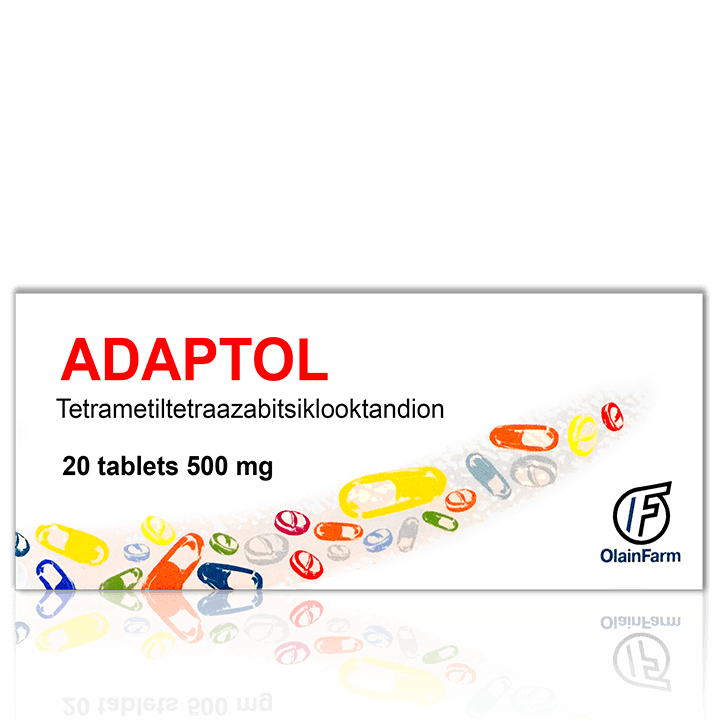Adaptol® (Mebicar) Instruction
International Non-Proprietary Name (INN): mebicar
Dosage form: tablets (500 mg)
Structure
1 pill contains:
Active ingredient: tetramethyltetraazabicyclooctandionum (mebicarum) 500 mg;
Excipients: methylcellulose, calcium stearate.
Description
Round, flat cylindrical tablets of white or almost white color with a facet and a break line.
Pharmacological classification: tranquilizer (anxiolytic)
ATC code: N05BX
Pharmacological action: anxiolytic, nootropic

Pharmacodynamics
The chemical structure of Adaptol® is similar to the natural metabolites of the organism. Its molecule contains two methylated urea fragments, which are part of a bicyclic structure.
Adaptol® has an effect on the activity of structures belonging to the limbic-reticular complex in particular on emotiogenic areas of the hypothalamus, and has an effect on all the four major neurotransmitter systems: GABA, cholinergic, serotonergic, and adrenergic, helping them to balance and to integrate, but it has no peripheral adrenoceptor blocking action.
Adaptol® eliminates or reduces anxiety, alarm, fear, internal emotional tension, and irritability. The soothing effect is not accompanied by muscle relaxation and loss of coordination. It does not disturb mental and motor performance, so Adaptol® can be taken during the workday or at school.
It does not create high spirits and a sense of euphoria. It does not have the drowsiness effect, but potentiates the effect of hypnotics and normalizes sleeping if disturbed. Adaptol® mitigates or relieves nicotine withdrawal symptoms.
It also has a nootropic effect. As clinical studies show, Adaptol® improves logical thinking, attention, and overall mental performance without stimulating symptoms of productive psychopathological disorders – deliration, pathological emotional activity.
Pharmacokinetics
Absorption: Adaptol® is quickly absorbed from the gastrointestinal tract (77–80%). The maximum concentration of the active ingredient in blood is reached in 0.5 hours after the administration. A high concentration of the active ingredient is maintained for 3-4 hours and then gradually decreases.
Distribution: Up to 40% of the dose binds with erythrocytes. The remaining part does not bind with plasma proteins and stays in the blood plasma in a free form, thus the active ingredient is freely distributed throughout the organism and it freely comes through the cell membranes.
Metabolism: The active ingredient is not metabolized and does not accumulate in the body.
Excretion: About 55–70% of the dose is excreted from the body in urine, the rest – in feces in the unchanged form during the day.
Intended uses
- neuroses and neurosis-like state (irritability, emotional instability, anxiety, fear);
- improvement of tolerability to neuroleptics and tranquilizers in order to eliminate somatic-vegetative and neurological side effects caused by them;
- cardialgia of various nature (if not caused by coronary heart disease);
- nicotine abstinence (as part of the complex therapy to reduce the tobacco addiction);
- mitigation of somatic-vegetative symptoms of premenstrual syndrome and menopause.
Contraindications
- hypersensitivity to ingredients of the drug;
- age below 18 years old;
- pregnancy and lactation.
Dosage and administration
Ingest by mouth without regard to timing of food: 500 mg 2-3 times a day. The maximum single dosage is 3 g; the maximum daily dosage is 10 g. The length of the treatment varies from several days to 2-3 months.
In the complex treatment of nicotine dependence, it is recommended to take 500–1000 mg 3 times a day for 5-6 weeks.
If you missed taking the drug, the treatment dosage should continue to be the same.
Side effects (rare)
Dizziness, decrease of arterial pressure, dyspeptic disorders, allergic reactions (skin rashes, itching).
(At high doses) bronchial spasm, declination of body temperature, weakness. Decrease of arterial pressure or body temperature does not require cessation of treatment. Blood pressure and body temperature return to normal on their own. In case of allergic reactions administration of the drug should be discontinued.
Overdose
The toxicity of Adaptol® is very low. If the dosage is significantly exceeded, the following symptoms may arise: weakness, arterial hypotension, and dizziness. In this case, it is necessary to conduct conventional treatment for detoxification including gastric lavage.
Interaction with other drugs
Adaptol® can be combined with antipsychotics, tranquilizers (including benzodiazepines), opiates, antidepressants, and psychostimulants.
Pregnancy and lactation
Adaptol® penetrates well into all tissues and fluids. There is not enough clinical study on the use of the drug during pregnancy and lactation (breastfeeding). Therefore it is not recommended to prescribe the drug to this category of patients.
Influence on the ability to drive vehicles and operate mechanisms
The drug can cause a decrease of arterial pressure and weakness, which can adversely affect the ability to drive vehicles and operate mechanisms. Special caution should be taken.
Terms of release from the pharmacy
On prescription.
Storage conditions
Store in a dry place at temperatures no higher than 25°C. Keep out of reach of children.
Shelf life
4 years. Do not use beyond the expiration date.
Manufacturer
OlainFarm, Latvia. https://olainfarm.com/